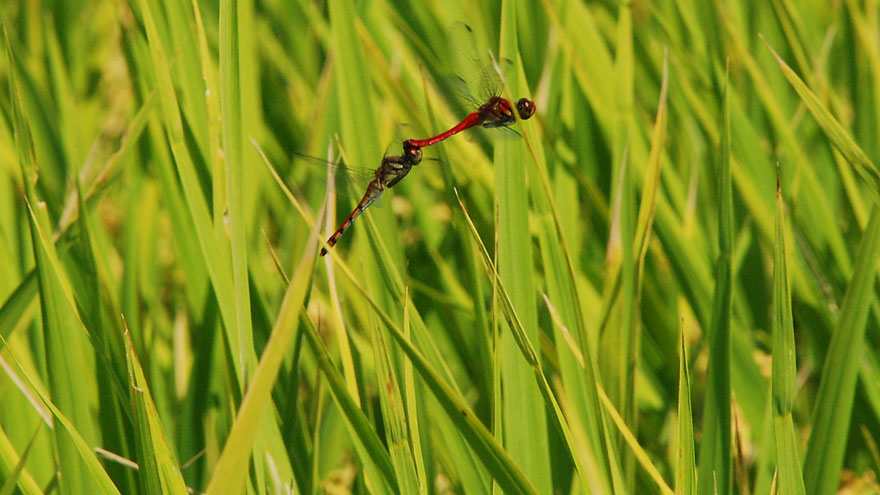Dragonflies and Paddy Fields
Paddy fields and Japanese
Figure 1. Sympetrum darwinianum, a couple ovipositing above the paddy field in tandem.
If you come to Japan, everywhere you go, you will find lots of paddy fields. We Japanese have lived on rice for more than 2500 years. In spring, the paddy fields were irrigated for setting young rice plants, called "TAUE" in Japanese, and then they are taken care of by farmers as they are always filled with water during from spring to early summer, rainy season, or "TSUYU". However in summer, dry season, they are drained, called "NAKABOSHI". Rice, Oryza sativa, grows rapidly in the season and then is croped in autumn.
Japanese paddy fields provide a habitat of odonates which have a short perid of aquatic stage restricted from spring to early summer such as
Sympetrum or
Gynacantha species. Indeed, several species use paddy fields as their main reproductive sites. Their life cycle synchronized with human activity of rice crop, that is, they hatch when being irrigated the paddy fields; they grow rapidly during being kept water there; and they emerge before draining.

Figure 2. Paddy field and an attached pool. Lyriothemis pachygastra and Orthetrum japonicum japonicum inhabit such a shallow pool.
Here, I will introduce some of such "paddy field dwellers.
Dragonflies and Paddy Fields
Odonates Living in Paddy Fields
The list below shows odonates (larvae or exuviae) that I have captured in paddy fields with those reported by Japanese odonatologists up to now.
| Species |
Reporter |
| 01. Mortonagrion selenion |
|
| 02. Cercion sieboldii |
Arai (1985) |
| 03. Indolestes peregrinus |
|
| 04. Gynacantha japonica |
|
| 05. Anax parthenope julius |
|
| 06. Lyriothemis pachygastra |
|
| 07. Orthetrum japonicum japonicum |
Arai (1985) |
| 08. Orthetrum albistylum speciosum |
|
| 09. Orthetrum triangulare melania |
Arai (1985) |
| 10. Sympetrum frequens |
|
| 11. Sympetrum darwinianum |
|
| 12. Sympetrum pedemontanum elatum |
|
| 13. Sympetrum eroticum eroticum |
|
| 14. Sympetrum baccha matutinum |
Taguchi (1997) |
| 15. Sympetrum parvulum |
Taguchi (1997) |
| 16. Sympetrum infuscatum |
Arai (1996) |
| 17. Pantala flavescens |
|
Left: Figure 3. Sympetrum infuscatum, a female resting in the afternoon of autumn by the paddy field.
Right: Figure 4. Sympetrum eroticum eroticum, wating for females by the paddy field.
Mortonagrion selenion, Paracercion sieboldii, Anax parthenope julius, Orthetrum albistylum speciosum, Orthetrum melania, Orthetrum japonicum japonicum and Lyriothemis pachygastra ordinarily overwinter in larval stage. They can be found, therefore, only in such paddy fields as to be kept water or wet condition during winter.
Left: Figure 5. Anax parthenope julius, ovipositing at the dried paddy field after mowing.
Right: Figure 6. A female Orthetrum japonicum japonicum is ovipositing with a guarding male among rice.
Individuals of Indolestes peregrinus overwinter in adult stage, oviposit in spring, hatch promptly, grow rapidly, and emerge in summer. Total duration of the aquatic stage is, however, about 95 days (K.R.G.O., 1984), so that it can be found only in such paddy fields as to be kept water during from spring to mid summer.
In contrast to above species, the rest species, except for Pantala flavescens, all overwinter in egg stage, hatch in spring, grow rapidly, and emerge in early summer. They probably do not require water in winter because at least four of them, i.e. S. frequens, S. darwinianum, S. baccha matutinum, S. infuscatum, could emerge from paddy fields which had been under dry condition in the preceding winter (Arai, 1985). Most of Japanese paddy fields have such condition, so that these odonates are the most adaptive there.
Left : Figure 7. Sympetrum frequens emerges in the paddy field. Right : Figure 8. Mortonagrion selenion ovipositing in the paddy field.
Adults of Pantala flavescens often emerge from paddy fields in early summer although any stages of P. flavescens cannot overwinter in central Japan. A few adults, which are the parents of populations of the year, come to central Japan in late April every year from the south probably crossing over the ocean, and then oviposit in paddy fields which are irrigated. The duration of aquatic stage of P. flavescens is, as you know, very short, i.e. egg stage in 5 days and larval stage in 34 days (K.R.G.O., 1984), so that their offspring (second generation) can emerge before the paddy fields are drained. Moreover, even the third generation (the offspring's offspring) could emerge. Therefore, P. flavescens is also adapted to Japanese paddy fields.
Dragonflies and Paddy Fields
Dragonflies are the most familiar insect of Japan
In ancient times, Japan was called "AKITSU-SHIMA" which means a dragonflies (= AKITSU) island (= SHIMA), and also called "TOYO-ASHIHARA-MIZUHO-NO-KUNI" which means a wet island having a rich crop. It is not difficult to imagine that a huge number of odonates emerged from paddy fields every year of those times. We Japanese had lived with odonates, which had been the most familiar insect of Japan. However, unfortunately, odonates around us have been reduced in number for the last 30 - 40 years probably due to modernized agriculture which uses various chemicals. Odonates are no longer familiar for Japanese children of the present age. I think it is one of pressing problems for Japanese odonatologists and naturalists being interested in odonates to conserve those familiar insects around us and in the country, Japan.
Left : Figure 9. Copulation (left) and oviposition (right) of Sympetrum frequens which is the most adopted species to the Japanese paddy field.
References
Arai, Y., 1985. Rice field and dragonflies. (1). Gracile 34:19-20. [-in Jap.].
Arai, Y., 1996. Adaptation of red-dragonflies in Japnese paddy fields. The Nature & Insects 31(8):23-26. [-in Jap.]
K.R.G.O., 1984. Dragonflies of Kinki District, Central Japan. (Kansai Reserch Group of Odonatology). [-in Jap.]
Taguchi, M., 1997. The home of Odonata. (Tombo no Sato.). Shinzan-sha. [-in Jap.]






